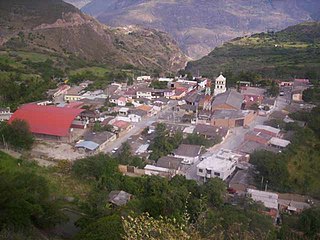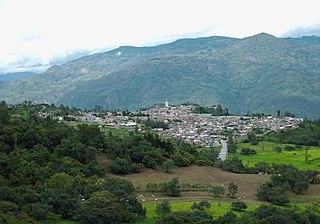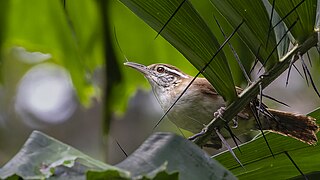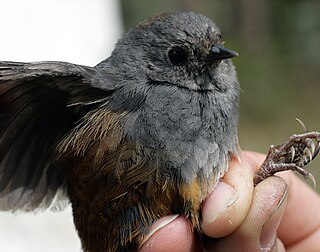
Wrens are a family of brown passerine birds in the predominantly New World family Troglodytidae. The family includes 88 species divided into 19 genera. Only the Eurasian wren occurs in the Old World, where, in Anglophone regions, it is commonly known simply as the "wren", as it is the originator of the name. The name wren has been applied to other, unrelated birds, particularly the New Zealand wrens (Acanthisittidae) and the Australian wrens (Maluridae).

The Carolina wren is a common species of wren that is a resident in the eastern half of the United States of America, the extreme south of Ontario, Canada, and the extreme northeast of Mexico. Severe winters restrict the northern limits of their range, while favorable weather conditions lead to a northward extension of their breeding range. Their preferred habitat is in dense cover in forest, farm edges, and suburban areas. This wren is the state bird of South Carolina.

Tipacoque is a municipality and town in Boyacá Department, Colombia, located on the Altiplano Cundiboyacense, part of the Eastern Ranges of the Colombian Andes. Tipacoque is situated on the western flank of the Chicamocha river canyon. It is part of the Northern Boyacá Province.

The rufous-and-white wren is a small songbird of the wren family. It is a resident breeding species from southwesternmost Mexico to northern Colombia and northwestern Venezuela. It was formerly placed in the genus Thryothorus.

Soatá is a town and municipality in Boyacá Department, Colombia. Soatá is located on the western slopes of the Cordillera Oriental mountain range, at the northeast end of the Department of Boyacá. It is the capital of the Northern Boyacá Province. Soatá borders Boavita in the east, Tipacoque in the north, Susacón in the south and in the west it borders the municipality Onzaga of the department of Santander.

The Yariguies brush finch is a subspecies of the yellow-breasted brush finch, discovered in 2004 in Colombia.
Fundación ProAves is a nonprofit environmental organization in Colombia established in 1998. Its primary aims are to protects birds of conservation concern and their habitats across Colombia.

The black inca is a species of hummingbird in the "brilliants", tribe Heliantheini in subfamily Lesbiinae. It is endemic to Colombia.
The San Gil climbing salamander, also known as the San Gil mushroomtongue salamander, is a species of salamander belonging to the family Plethodontidae. It is endemic to Colombia, and its natural habitats are tropical highly humid forests; it has also been reported from a coffee plantation. The greatest threat posed to this species is habitat loss, however they are currently nowhere near the risk of extinction. The species' name honors Antoine Rouhaire, a French naturalist who collected the species holotype.

The flame-winged parakeet, also known as the brown-breasted parakeet, is a species of parrot in the family Psittacidae. It is endemic to forest edge and shrub at altitudes of 1,700–3,400 m (5,600–11,200 ft) above sea level on the east Andean slope in Colombia. It is threatened by habitat loss.

The moustached brushfinch is a species of bird in the family Passerellidae.

Thryophilus is a genus of wrens in the Troglodytidae (wren) family. It contains five species, which were previously classified in Thryothorus.
Cerulean Warbler Bird Reserve, known in Spanish as Reserva Natural de las Aves Reinita Cielo Azul, is a nature reserve near Bucaramanga in central Colombia. The reserve is set among oak forest on the eastern slopes of the Magdalena River. It measures 545 acres (221 ha) and adjoins the Yariguíes National Park.
Yariguíes National Park is a natural park in north central Colombia. It is located in the Santander department and measures 78,837 hectares. It was officially designated as a national natural park in 2005.

The Antioquia wren is a passerine from the wren family (Troglodytidae). It was discovered in March 2010 in the vicinity of the Cauca River in Antioquia, Colombia and described as a new species by Lara et al (2012). The epithet commemorates the late Marco Antonio Serna Díaz (1936–1991), a Colombian naturalist from San Vicente Ferrer, Antioquia.

The Chicamocha Canyon is a steep sided canyon carved by the Chicamocha River in Colombia. With a maximum depth of 2,000 metres (6,600 ft), an area of 108,000 hectares and a length of 227 kilometres (141 mi), the canyon is the second-largest worldwide. The canyon is situated in the departments of Boyacá and Santander, stretching from Soatá in the southeast to Girón and Betulia in the northwest.

The Perijá tapaculo is a species of passerine bird in the family Rhinocryptidae (tapaculos). Endemic to the Serranía del Perijá mountain range on the Colombia–Venezuela border, the Perijá tapaculo is found at altitudes of 1,600–3,225 metres. Its body is 10 to 12 centimetres long and its tail is about 4 cm (1.6 in) long. Specimens have long been stored in museums, but the species was described only in 2015 based on sixteen specimens found between July 2008 and February 2009. It is considered vulnerable to extinction.

The Cordillera Oriental montane forests (NT0118) is an ecoregion in Venezuela and Colombia along the east slopes of the eastern cordillera of the Andes. The extensive region of submontane and montane forests includes distinctive flora and fauna in the north, center and southern sections. The ecoregion is home to numerous endemic species of fauna. Despite extensive changes due to logging, farming and ranching, large areas of the original habitat remain intact, and the ecoregion has rich biodiversity.

The Soatá Formation is a geological formation of the northern Altiplano Cundiboyacense, Eastern Ranges of the Colombian Andes. The formation consists mainly of shales with conglomerates and dates to the Quaternary period; Late Pleistocene epoch. The heavily eroded formation has a maximum measured thickness of 30.8 metres (101 ft). It contains the lacustrine and fluvio-glacial sediments of elongated paleolake Soatá, that existed on the Altiplano in the valley of the Chicamocha River.

The Magdalena Valley montane forests (NT0136) is an ecoregion in the Andes mountains of central Colombia.


















